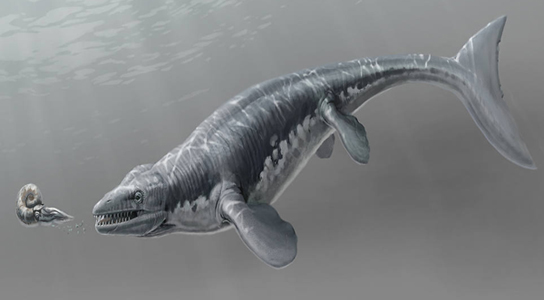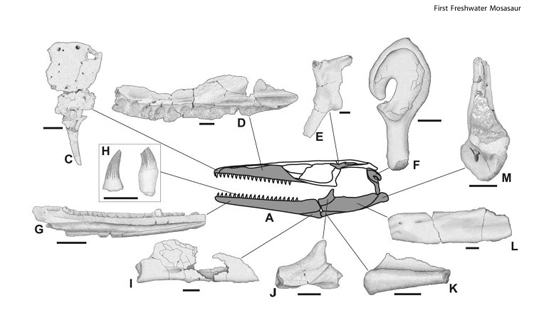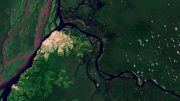
Discovered in August 2010, the mosasaur Platecarpus was a marine lizard, like most other mosasaurs so far discovered. Credit: Illustration by Stephanie Abramowciz, NHM Dinosaur Institute
A new species of mosasaur was discovered in Hungry, providing the first evidence that mosasaurs lived in both freshwater and marine environments.
The scientists published their findings in the journal PLoS ONE. The first mosasaur was discovered in 1764, and since then, thousands of specimens have been discovered. Until now, paleontologists had no evidence that they lived in freshwater environments and it was assumed that they were exclusively marine predators.

Skeletal anatomy of the first freshwater mosasaur, Pannoniasaurus inexpectatus, found in Hungary. Credit: Makadi L, Caldwell MW, Osi A (2012)
In 1999, a vertebra was discovered alongside a variety of fish and crocodile teeth in a waste dump of a coal mine in an industrial town in Western Hungary. This was the first known specimen of this mosasaur, named Pannoniasaurus inexpectatus. In 2000, in a dried-up river system, more fragmentary vertebrae of P. inexpectatus were found. The fossils were so fragmentary that they were mistaken for the bones of large terrestrial lizards.
It wasn’t until the recent discovery of more bones, including the all-important skull bones, that paleontologists realized that they had been piecing together a very unusual species of ancient aquatic reptile. The researchers have now collected over 100 P. inexpectatus bones from large and small individuals.
P. inexpectatus lived between 85.8 to 83.5 million years ago, during the Late Cretaceous period. It thrived in the freshwater river system in the western Tethyan Archipelago, a series of island chains that sat between the African and Eurasian landmasses in the Tethys Ocean.
The scientists think that P. inexpectatus could have grown up to six meters (20 feet) in length, making it the largest aquatic predator of its environment. It was apparently specialized for its freshwater environment, having a flattened skull like a crocodile for ambushing prey on land and in shallow water and possibly limbs like a terrestrial lizard. The scientists believe Pannoniasaurus adapted to the freshwater environment much like modern river dolphins adapted to life in the Amazon, Ganges, Yangtze and La Plata River.
Reference: “The First Freshwater Mosasauroid (Upper Cretaceous, Hungary) and a New Clade of Basal Mosasauroids” by László Makádi, Michael W. Caldwell and Attila Ősi, 19 December 2012, PLoS ONE.
DOI: 10.1371/journal.pone.0051781









Be the first to comment on "Pannoniasaurus inexpectatus, The First Freshwater Mosasaur Discovered"